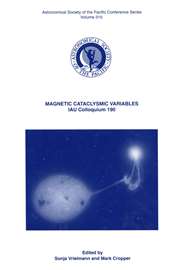No CrossRef data available.
Article contents
Microstructure and the Pulsar Emission Mechanism
Published online by Cambridge University Press: 12 April 2016
Extract
Pulsar radio emission is composed in varying proportions of microstructure, subpulses and amorphous emission. Each component has its own time and frequency behaviour. The average pulse profile changes its width with frequency, typically as ν −0.26. The location (pulse phase) of the subpulses refered to a fiducial point within the profile follows the same ν −0.26 law as the width of the average pulse profile. The fiducial point in the pulse profile follows the interstellar plasma dispersion relation exactly: the source emission at this phase is simultaneous at all frequencies. The subpulse width is typically nearly constant with frequency. Emission of a subpulse may be systematically absent at certain frequency ranges, the pulse profile may be different there. Micropulses are typically very wideband: ∼1GHz or more. Individual micropulse widths are constant with frequency. Its time width distributions have upper limits (0.1-1 ms). The time separation (phase) of any micropulse with respect to the fiducial point is constant with frequency, i.e. it is simultaneous at all frequencies at source. The spectrum of individual micropulses appears to have breakpoints: it is observable at ν ≤ ν (μ co), but not above it. This effect (and not a steep spectrum) seems to account for the smaller number of micropulses at higher frequencies: at ν we see micropulses with ν (μ co) > ν only, micropulses with ν (μ co) < ν are not visible, at low frequencies we will see more micropulses than at high frequencies. Micropulses prefer the conal emission zones, and are very weak or absent in the core emission zones. More than one micropulse can be observed at a given time. Micropulses occasionally appear in trains with a nearly constant time separation, up to 20 micropulses have been observed in such quasi-periodic sequences. Sequence phase and period are variable within a train, they may have discrete values. Such trains can be observed simultaneously at widely separated frequencies. Ocasionally more than one quasi-periodic train may appear at the same time. Subpulses in general follow the linear polarization angle of the average pulse profile, with occasional 90° jumps. Within a micropulse the polarization angle can be constant, or can have a fast swing of ∼ 50°. Micropulse polarization angle can be widely different from that of the subpulse on which it is superimposed.
Information
- Type
- Part 3 Radio Emission Processes
- Information
- International Astronomical Union Colloquium , Volume 160: Pulsars: Problems and Progress , 1996 , pp. 187 - 188
- Copyright
- Copyright © Astronomical Society of the Pacific 1996

